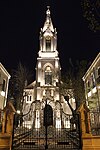26 Baku Commissars Memorial
Buildings and structures demolished in 2009Demolished buildings and structures in AzerbaijanMonuments and memorials built in the Soviet UnionMonuments and memorials in AzerbaijanPropaganda in the Soviet Union

The 26 Baku Commissars Memorial was a Soviet-era monument located in Baku, Azerbaijan, that paid tribute to the 26 Baku Commissars from the Baku commune. The commune was overthrown in 1918 and the commissars later executed near Krasnovodsk (now Türkmenbaşy). The monument was constructed by sculptors I. Zeynalov and N. Mamedov, and architects G. Aleskerov and Alesker Huseynov, who eventually became a prominent politician in Azerbaijan. The remains of the Commissars were buried at the site of the memorial.
Excerpt from the Wikipedia article 26 Baku Commissars Memorial (License: CC BY-SA 3.0, Authors, Images).26 Baku Commissars Memorial
Uzeir Hajibeyov, Baku City
Geographical coordinates (GPS) Address Nearby Places Show on map
Geographical coordinates (GPS)
| Latitude | Longitude |
|---|---|
| N 40.37309 ° | E 49.845643 ° |
Address
Tualet
Uzeir Hajibeyov
1000 Baku City (Sabail Raion)
Baku, Azerbaijan
Open on Google Maps







